-
Page 2
-
History of Knight's Key Dock 1908 to 1912
-
By Jerry Wilkinson
-
- Continued -
-
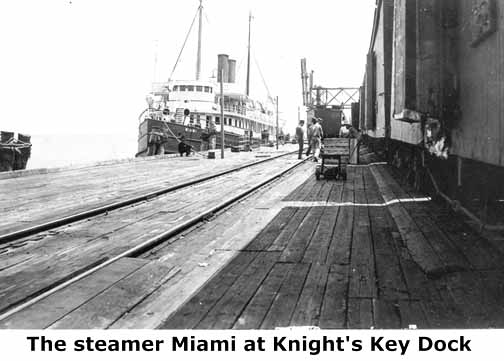 On page one we left Knight's Key Dock in operational 1908 providing passenger
and freight service and connecting the Florida mainland with steamship
service throughout the world. The photo to the right could be later than
1908 but it depicts the concept of the arrangement. There was another set
of tracks and a dock on the other side. From this time on, the dock will
serve passengers as well as incoming material to build the Seven Mile Bridge
and others bridges to its south. One change is that some material can be
moved by rail using rolling stock (rail mounted equipment).
On page one we left Knight's Key Dock in operational 1908 providing passenger
and freight service and connecting the Florida mainland with steamship
service throughout the world. The photo to the right could be later than
1908 but it depicts the concept of the arrangement. There was another set
of tracks and a dock on the other side. From this time on, the dock will
serve passengers as well as incoming material to build the Seven Mile Bridge
and others bridges to its south. One change is that some material can be
moved by rail using rolling stock (rail mounted equipment).
-
Work on the Seven Mile Bridge did
not begin immediately after the dock opened in February 1908. The reason
is not exactly clear, as the story goes, it had been a "marathon" to open
Knights Key Dock. Quite possibly it was because during the last of the
year 1907 up through November 1908 the government's peonage lawsuit against
Henry Flagler was in progress.
-
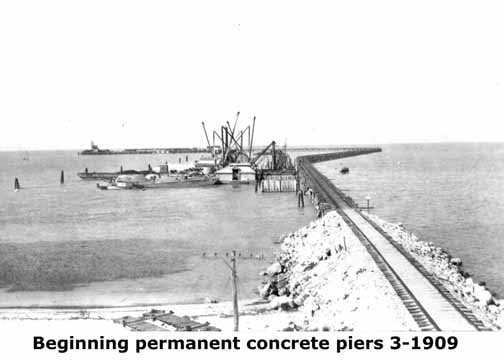 The photo on the right clearly shows the "question mark" shaped wooded
trestle extending out to the dock area. It also depicts the construction
of some concrete piers to left (east) side. These piers will eventually
proceed to Pigeon Key where work had also begun. Piers with steel trusses
were used where the water was too deep to build bridges of arch construction.
Note the quantity of barge mounted steam operated equipment for placing/removing
of concrete forms, pouring concrete, etc.
The photo on the right clearly shows the "question mark" shaped wooded
trestle extending out to the dock area. It also depicts the construction
of some concrete piers to left (east) side. These piers will eventually
proceed to Pigeon Key where work had also begun. Piers with steel trusses
were used where the water was too deep to build bridges of arch construction.
Note the quantity of barge mounted steam operated equipment for placing/removing
of concrete forms, pouring concrete, etc.
-
On April 20, 1909 the chief construction
engineer, James Meredith, died and William J. Krome is called up as his
replacement.
-
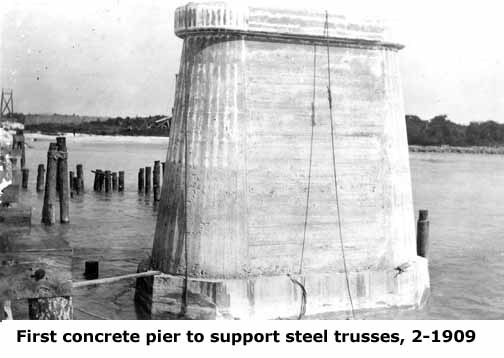 To the right is shown the first concrete pier completed with the island
of Knight's Key in the background. This completed pier lends credence to
the theory that construction of the final part of the Key West Extension
began on January 1, 1909. To complete the steel truss portion of the Seven
Mile Bridge 334 more piers were constructed. Most of these spans were 80
feet center to center with an 80-foot steel deck plate girder between.
About the center of the bridge and just past Pigeon Key was the Moser Channel
draw (swing) bridge.
To the right is shown the first concrete pier completed with the island
of Knight's Key in the background. This completed pier lends credence to
the theory that construction of the final part of the Key West Extension
began on January 1, 1909. To complete the steel truss portion of the Seven
Mile Bridge 334 more piers were constructed. Most of these spans were 80
feet center to center with an 80-foot steel deck plate girder between.
About the center of the bridge and just past Pigeon Key was the Moser Channel
draw (swing) bridge.
-
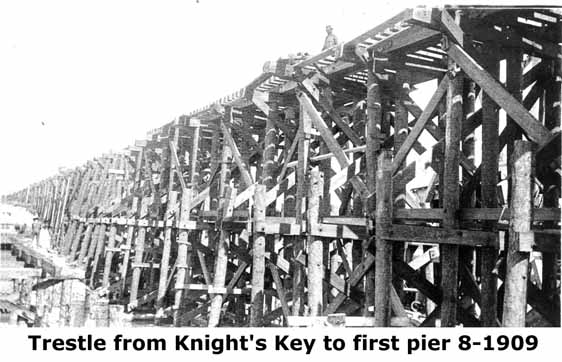 A wooden trestle was constructed from the island of Knight's Key out
to a concrete bridge wave deflecting abutment. This area formed the bottom
part of the "question mark" configuration. At the Knight's Key end the
trestle was about 30 feet high as high waves were expected during hurricanes.
Rock fill was later dumped in and around the trestle supports using Baldwin
side dump cars to make a solid bridge approach. The concrete wave deflecting
abutment terminated the approach and was the beginning support element
for the 335 steel trusses. The abutment is seen in the next photo.
A wooden trestle was constructed from the island of Knight's Key out
to a concrete bridge wave deflecting abutment. This area formed the bottom
part of the "question mark" configuration. At the Knight's Key end the
trestle was about 30 feet high as high waves were expected during hurricanes.
Rock fill was later dumped in and around the trestle supports using Baldwin
side dump cars to make a solid bridge approach. The concrete wave deflecting
abutment terminated the approach and was the beginning support element
for the 335 steel trusses. The abutment is seen in the next photo.
-
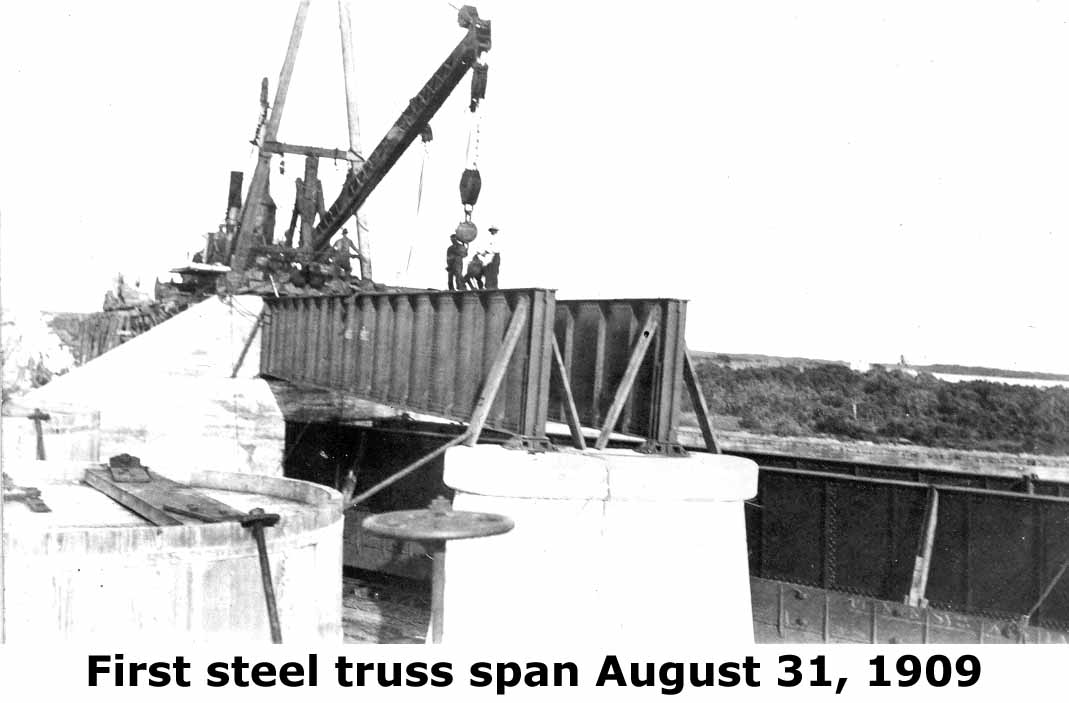 On August 31, 1909 the first steel span (two steel girders with bracing)
was bolted in place on the concrete abutment and the first pier; thus completed
the first concrete pier of the Seven Mile Bridge.
On August 31, 1909 the first steel span (two steel girders with bracing)
was bolted in place on the concrete abutment and the first pier; thus completed
the first concrete pier of the Seven Mile Bridge.
-
The wooden trestle can just be
seen in the background extending to the island. Track had been laid on
the trestle to allow heavy-duty steam operated rolling stock equipment
to do the heavy work of placing the trusses. Note the relative size of
the men on top of the truss and the height of the truss.
-
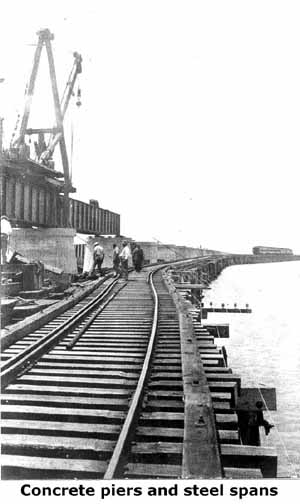 When viewed carefully, the next photo clearly depicts the relationship
of the wooden trestle with track leading out to the dock area and the permanent
Seven Mile Bridge piers and steel spans proceeding towards Pigeon Key.
There are also telegraph and telephone lines strung on insulators along
the outside of the track.
When viewed carefully, the next photo clearly depicts the relationship
of the wooden trestle with track leading out to the dock area and the permanent
Seven Mile Bridge piers and steel spans proceeding towards Pigeon Key.
There are also telegraph and telephone lines strung on insulators along
the outside of the track.
-
Note the train at the middle-right
that is either going to or coming from Knight's Key Dock. There is also
no turn around out on the dock so the locomotive cannot be switched from
one end of the train to the other. Some believe that the train turned around
at the Marathon wye and backed out to the dock area. A wye is a "Y" formation
of track so a complete train could back in and pull out in the opposite
direction therefore changing directions. Wyes were at Homestead, Marathon
and Key West.
-
The hurricanes of 1909 and 1910
came and went, but again Knight's Key Dock survived. Now to connect the
permanent bridge to Pigeon Key.
-
-
-
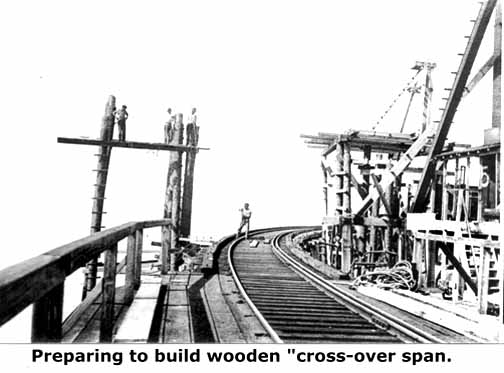 Thinking forward the reason for the "question mark' route for the track
to Knight's Key Dock becomes apparent. The chosen location for the dock
and the permanent route to Key West required the tracks to cross over water.
The method chosen was for the permanent track to Pigeon Key to pass over
the top of the soon to be un-needed track to the dock. A problem was the
steel trusses were so tall that if put in place a train could not pass
under. The solution was since the construction locomotives were much smaller
than passenger locomotives (weighed less) that a temporary wooden truss
with two additional wooden supports would be used.
Thinking forward the reason for the "question mark' route for the track
to Knight's Key Dock becomes apparent. The chosen location for the dock
and the permanent route to Key West required the tracks to cross over water.
The method chosen was for the permanent track to Pigeon Key to pass over
the top of the soon to be un-needed track to the dock. A problem was the
steel trusses were so tall that if put in place a train could not pass
under. The solution was since the construction locomotives were much smaller
than passenger locomotives (weighed less) that a temporary wooden truss
with two additional wooden supports would be used.
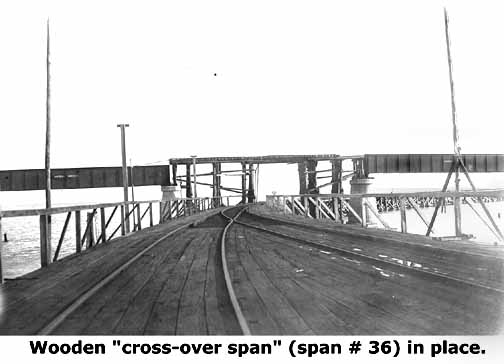 To the right is shown the cross-over span and its supports in place
ready to be connected to track when it is placed on the steel trusses.
Since this is a photo taken from Knight's Key dock, also visible are the
two sets of track that go to each side so that each ship can be serviced
by its own train, or vice versa.
To the right is shown the cross-over span and its supports in place
ready to be connected to track when it is placed on the steel trusses.
Since this is a photo taken from Knight's Key dock, also visible are the
two sets of track that go to each side so that each ship can be serviced
by its own train, or vice versa.
Below is Knight's Key Dock
seen from above on the permanent tracks passing above with the cross-over
span in place. The large building at the entrance to the dock area is a
hotel. By December 1909 piers and trusses were completed to Pigeon Key.
The trestle to the dock being relatively low to the water was damaged by
the 1909 Hurricane when a boat was washed into it. Other than that there
was no serious damage, but ship and rail traffic was suspended for a month.
There was one casualty in the Marathon area. The Atlantic Ocean is
to the left and Pigeon Key is somewhere in the background. Knight's Key
Dock survived the Hurricane of 1910 with insignificant damage.
-
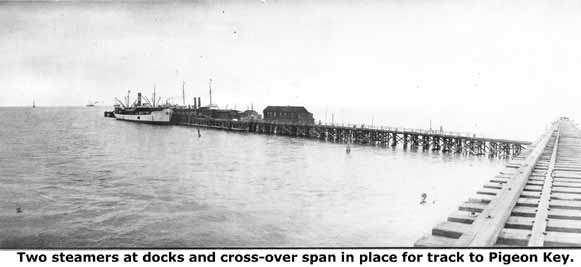
-
 Knight's Key Dock served Henry Flagler well during its period. As the
construction and track was completed to Key West, span number 36 being
of wood was the last impediment to heavy passenger trains traveling to
Key West. As the completion of the entire track became a reality plans
to move all the facilities from the dock were made. This involved a complete
phasing out of all operations and removal of any equipment and material
that required the use of a train. Once the tall steel truss was in
place only the small hand cars could pass under.
Knight's Key Dock served Henry Flagler well during its period. As the
construction and track was completed to Key West, span number 36 being
of wood was the last impediment to heavy passenger trains traveling to
Key West. As the completion of the entire track became a reality plans
to move all the facilities from the dock were made. This involved a complete
phasing out of all operations and removal of any equipment and material
that required the use of a train. Once the tall steel truss was in
place only the small hand cars could pass under.
-
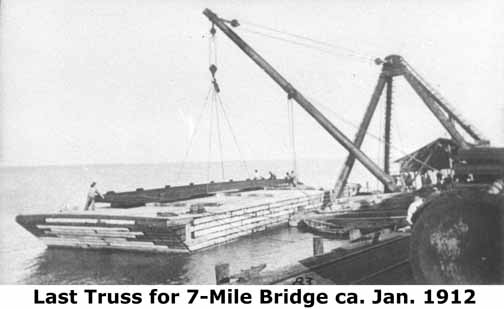 The exact timing for preparing for the removal of the wooden truss is not
known; however, an undated photo of it being unloaded from a barge is shown
to the right. As the day for through rail traffic to Key West approached,
every detail was planned to have everything on site for a smooth transition.
This was the day before for which so many had worked for. In the previous
photo William J. Krome posed just before the span was removed.
The exact timing for preparing for the removal of the wooden truss is not
known; however, an undated photo of it being unloaded from a barge is shown
to the right. As the day for through rail traffic to Key West approached,
every detail was planned to have everything on site for a smooth transition.
This was the day before for which so many had worked for. In the previous
photo William J. Krome posed just before the span was removed.
-
-
-
-
-
-
-
-
-
-
-
-
-
 On January 21, 1912 the wooden cross-over span was removed and steel truss
number 36 was bolted in place. Again William J. Krome posed after
the wooden span was removed and the steel truss was being bolted in place.
Cross ties and track were quickly secured and the final spike was driven
into a cross tie for the physical completion of the Key West Extension.
A survey train was sent over the tracks and a test trip of all the new
fill, bridges and track was completed in preparation for Mr. Flager's inaugural
trip.
On January 21, 1912 the wooden cross-over span was removed and steel truss
number 36 was bolted in place. Again William J. Krome posed after
the wooden span was removed and the steel truss was being bolted in place.
Cross ties and track were quickly secured and the final spike was driven
into a cross tie for the physical completion of the Key West Extension.
A survey train was sent over the tracks and a test trip of all the new
fill, bridges and track was completed in preparation for Mr. Flager's inaugural
trip.
-
-
-
-
-
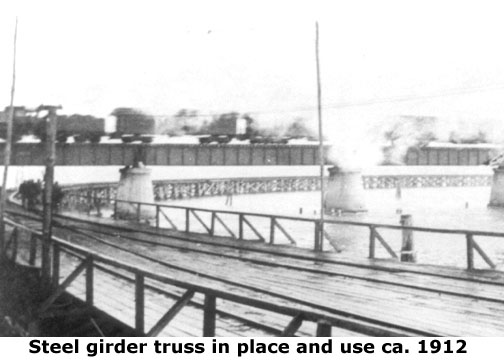 The following day, Henry Flagler and his entourage, made the inaugural
trip forever opening the Florida Keys for everything that daily transportation
brings. It is not known whether the photo to the right is the test trip
or the actual inaugural trip. Note the group of people standing below.
The following day, Henry Flagler and his entourage, made the inaugural
trip forever opening the Florida Keys for everything that daily transportation
brings. It is not known whether the photo to the right is the test trip
or the actual inaugural trip. Note the group of people standing below.
-
There is no photo of the demise
of Knight's Key Dock. Stories abound, one being that it was a total liability,
of no use and was burned to the waterline. Some artifacts, as the ones
pictured in the beginning, have been retrieved, but those, a few photographs
and written accounts such as this are probably all that remain of the tiny
village 89 years ago.
-
- - - - - END - - - -
-
Use Back Arrow to return to reading
previous page or:
-
To return to the Specific Locations
and Keys homepage,
Click HERE.
|
On page one we left Knight's Key Dock in operational 1908 providing passenger and freight service and connecting the Florida mainland with steamship service throughout the world. The photo to the right could be later than 1908 but it depicts the concept of the arrangement. There was another set of tracks and a dock on the other side. From this time on, the dock will serve passengers as well as incoming material to build the Seven Mile Bridge and others bridges to its south. One change is that some material can be moved by rail using rolling stock (rail mounted equipment).
The photo on the right clearly shows the "question mark" shaped wooded trestle extending out to the dock area. It also depicts the construction of some concrete piers to left (east) side. These piers will eventually proceed to Pigeon Key where work had also begun. Piers with steel trusses were used where the water was too deep to build bridges of arch construction. Note the quantity of barge mounted steam operated equipment for placing/removing of concrete forms, pouring concrete, etc.
To the right is shown the first concrete pier completed with the island of Knight's Key in the background. This completed pier lends credence to the theory that construction of the final part of the Key West Extension began on January 1, 1909. To complete the steel truss portion of the Seven Mile Bridge 334 more piers were constructed. Most of these spans were 80 feet center to center with an 80-foot steel deck plate girder between. About the center of the bridge and just past Pigeon Key was the Moser Channel draw (swing) bridge.
A wooden trestle was constructed from the island of Knight's Key out to a concrete bridge wave deflecting abutment. This area formed the bottom part of the "question mark" configuration. At the Knight's Key end the trestle was about 30 feet high as high waves were expected during hurricanes. Rock fill was later dumped in and around the trestle supports using Baldwin side dump cars to make a solid bridge approach. The concrete wave deflecting abutment terminated the approach and was the beginning support element for the 335 steel trusses. The abutment is seen in the next photo.
On August 31, 1909 the first steel span (two steel girders with bracing) was bolted in place on the concrete abutment and the first pier; thus completed the first concrete pier of the Seven Mile Bridge.
When viewed carefully, the next photo clearly depicts the relationship of the wooden trestle with track leading out to the dock area and the permanent Seven Mile Bridge piers and steel spans proceeding towards Pigeon Key. There are also telegraph and telephone lines strung on insulators along the outside of the track.
Thinking forward the reason for the "question mark' route for the track to Knight's Key Dock becomes apparent. The chosen location for the dock and the permanent route to Key West required the tracks to cross over water. The method chosen was for the permanent track to Pigeon Key to pass over the top of the soon to be un-needed track to the dock. A problem was the steel trusses were so tall that if put in place a train could not pass under. The solution was since the construction locomotives were much smaller than passenger locomotives (weighed less) that a temporary wooden truss with two additional wooden supports would be used.
To the right is shown the cross-over span and its supports in place ready to be connected to track when it is placed on the steel trusses. Since this is a photo taken from Knight's Key dock, also visible are the two sets of track that go to each side so that each ship can be serviced by its own train, or vice versa.
Knight's Key Dock served Henry Flagler well during its period. As the construction and track was completed to Key West, span number 36 being of wood was the last impediment to heavy passenger trains traveling to Key West. As the completion of the entire track became a reality plans to move all the facilities from the dock were made. This involved a complete phasing out of all operations and removal of any equipment and material that required the use of a train. Once the tall steel truss was in place only the small hand cars could pass under.
The exact timing for preparing for the removal of the wooden truss is not known; however, an undated photo of it being unloaded from a barge is shown to the right. As the day for through rail traffic to Key West approached, every detail was planned to have everything on site for a smooth transition. This was the day before for which so many had worked for. In the previous photo William J. Krome posed just before the span was removed.
On January 21, 1912 the wooden cross-over span was removed and steel truss number 36 was bolted in place. Again William J. Krome posed after the wooden span was removed and the steel truss was being bolted in place. Cross ties and track were quickly secured and the final spike was driven into a cross tie for the physical completion of the Key West Extension. A survey train was sent over the tracks and a test trip of all the new fill, bridges and track was completed in preparation for Mr. Flager's inaugural trip.
The following day, Henry Flagler and his entourage, made the inaugural trip forever opening the Florida Keys for everything that daily transportation brings. It is not known whether the photo to the right is the test trip or the actual inaugural trip. Note the group of people standing below.

